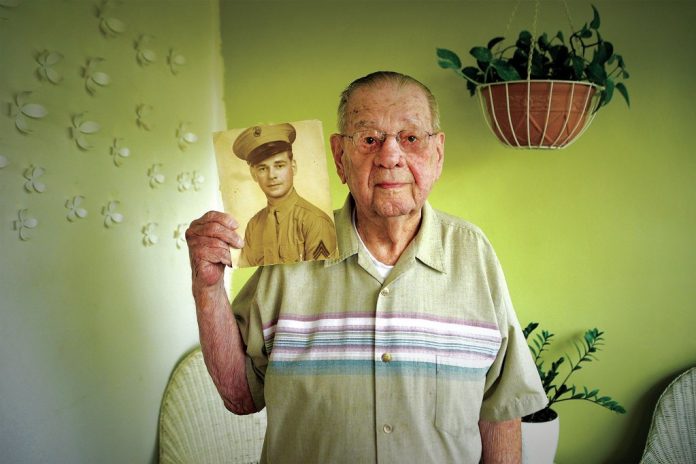World War II veteran Tony Lapkiewicz talks about what it was like to be a Marine at Iwo Jima, the Japanese island where a famous photograph of American soldiers raising the flag took place. Mr. Lapkiewicz is now 94 years old. (Maria Pouchnikova)
Anthony Lapkiewicz of Rhawnhurst remembers the first time he heard of the Japanese island called Iwo Jima.
He was just 23 years old, a Marine tank commander from Burholme who was aboard a ship that had steamed out of the harbor in Hawaii for parts unknown.
“After two days at sea, they showed us a map,” he said. “It looked like a pork chop. No one had ever heard of it.”
Soon, though, that small island riven with caves and covered in volcanic ash, only 650 miles from Tokyo, would become famous for one of the bloodiest battles of World War II. A hard-fought American victory created a vital link for U.S. bombers on their way to and from Japan.
On this Memorial Day weekend, Lapkiewicz, 94, agreed to an interview over a cup of coffee at a Northeast Philly diner, where he talked about one of the most important days of his life. He brought with him an envelope with black and white photos of his days as a young Marine, and wore on his head a cardinal red baseball cap inscribed with the words “Iwo Jima.”
It was there, early on the morning of Feb. 19, 1945, that big guns on the Navy ships pounded the island in preparation for the invasion. Lapkiewicz and his fellow Marines were roused before dawn and offered a special breakfast — steak and eggs.
“I was scared, scared as hell,” Lapkiewicz recalled. So, he went into the galley and got a cook to make him “a Polish breakfast” of eggs and onions.
“How can you keep a steak down when you’re scared as hell?” he asked.
Later that morning, his tank, “The Avenger,” rolled down the landing craft’s ramp and onto a southern beach. The Japanese, from caves, in pillboxes and from 550-foot-tall Mount Suribachi, laid deadly fire on the beaches.
“It was crazy,” Lapkiewicz recalled of the scene around him on the beach.
A gunnery sergeant making all of $126 a month, he was in charge of the Sherman Tank’s five-man crew. He ordered the driver to turn right to get the steel-plated hulk onto flat terrain.
“The Avenger” had gone about 100 yards when it hit a mine and its tread blew off. Lapkiewicz and his crew evacuated, and crawled into a crater that had been dug by a 16-inch Navy shell. That’s where they spent their first night on Iwo Jima, waiting for the repair crew that would come with daylight.
His crew, including a tank driver, assistant driver, loader and gunner, was assigned to C Company, Fifth Tank Battalion, 5th Marine Division. Their mission: To support the 28th Marine regiment in taking Mount Suribachi.
“We were to fire in front of the guys going up Mount Suribachi, to provide protective cover,” he said.
After five days of fierce fighting, the Marines captured the strategic high point. Lapkiewicz and his crew were about a mile away and did not see the American flag raised atop Mount Suribachi, but they certainly knew of it.
“I thought the island was secure,” he said. “But the worst wasn’t over yet.”
His tank made an about face and headed to the northern part of the island. “The Avenger” hit another mine, and with Japanese soldiers all around, he and his men had to evacuate. Another Marine tank pulled up right behind and Lapkiewicz’s crew piled inside. They were stuffed cheek-by-jowl inside the tank, but made it safely back behind front lines.
There, he was assigned another tank, “The Five Aces,” which was a flamethrower. The mission: To shoot flames into the caves where the Japanese soldiers were hiding, burning them up or causing them to die of suffocation.
“It was dog eat dog,” he said of the more than a month of fighting.
The death toll on both sides was very high, as 6,825 Marines were killed, and one in three who landed were either killed or wounded. Virtually all 21,000 Japanese soldiers were killed.
Lapkiewicz survived and returned to his base in Hawaii where an off-duty motorcycle accident prevented him from moving up to second lieutenant. He was discharged in 1946.
He built a life back in Northeast Philadelphia with his wife, Marie. They had two children, Charles and Margaret. At first, he worked as a guard at the former Cramps Shipyard along the Delaware River, then opened a hoagie shop in Wissinoming, across from what used to be called Chink’s sandwich shop.
He landed a job as a letter carrier, lived in Academy Gardens, and after a lengthy career, retired from the Post Office in Holmesburg in December 1980.
For 40 years, he marched with the Ferko String Band up Broad Street, playing the violin no matter how cold the New Year’s Day.
His wife died the same year he retired, and he has since made it a point of staying busy, leaving his home in Rhawnhurst three days a week to work out at a gym.
Lapkiewicz said he keeps in touch with one former fellow Marine, Myron Czubko of Jackson, Mich. They talk on the phone twice a year, at Christmas and Easter.
But his memories of his Marine buddies and what happened on Iwo Jima mostly have faded in the seven decades that have passed since the day Lapkiewicz was too scared to eat steak for breakfast.
“You think about them every once in a while,” he said. “Usually, I try not to think about it.” ••
Reach editor Lillian Swanson at 215–354–3030 or [email protected]





